
Designing Cisco Enterprise Networks (ENSLD)
Last Update Jan 21, 2026
Total Questions : 339
We are offering FREE 300-420 Cisco exam questions. All you do is to just go and sign up. Give your details, prepare 300-420 free exam questions and then go for complete pool of Designing Cisco Enterprise Networks (ENSLD) test questions that will help you more.




Refer to the exhibit A customer requires maximum uptime for the data plane between R1 and R3 running OSPF Which solution must the design include for high availability if the routing process on R2 requires maintenance?
An engineer is designing a Layer 3 campus network running EIGRP between the core, aggregation, and access layers. The access layer switches will be connected to the aggregation layer using Layer 3 copper connections. The engineer wants to improve convergence time for access layer switch failures. Which technique must the design include?
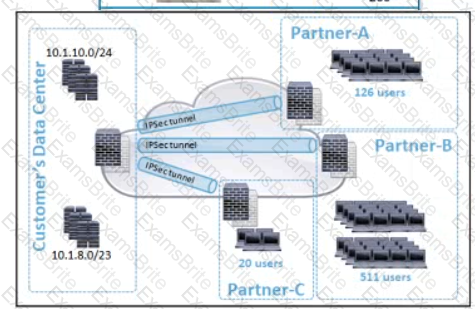
Refer to the exhibit. A customer is planning to onboard three new VPN partner connections in the data center. The new subnets must not overlap with the existing data center network, and the subnet size must not be bigger than necessary. The customer dedicated 10.1.8.0/21 for this design. Ho1// must the subnets be divided to meet these requirements?
A)

B)

C)

D)

A customer requires QoS to support multimedia conferencing over MPLS. The network architect chooses to use per-hop behavior. Which solution must the architect use to classify and mark traffic traveling between branch sites?
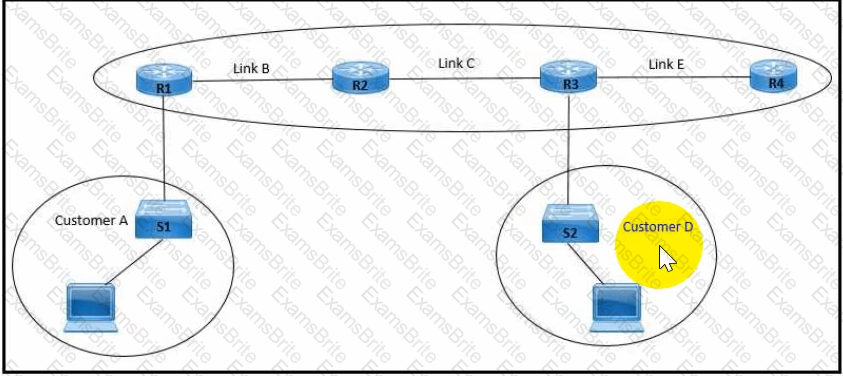
Refer to the exhibit An architect is designing an IPv4 plan using the 172 20 0.0/16 network The design must maximize the number of subnets and minimize the number of wasted IP addresses In addition, the plan must allocate a subnet to these customers and links
Customer A, which supports 125 hosts
Customer D, which supports 62 hosts
Links B C. and E
Which two configuration sets meet these requirements'? (Choose two)
A)

B)

C)

D)

E)

An engineer is tasked with designing a dual BGP peering solution with a service provider. The design must meet these conditions:
The routers will not learn any prefix with a subnet mask greater than /24.
The routers will determine the routes to include in the routing table based on the length of the mask alone.
The routers will make this selection regardless of the service provider configuration.
Which solution should the engineer include in the design?
An architect is working on a design to connect a company's main site to several small to medium-sized remote branches. The solution must include redundant WAN links, but the customer has a limited budget and wants the ability to increase the link speed easily in the future. QoS will not on the branch routers so there is no need for consistent end-to-end QoS. Which solution does the architect propose?
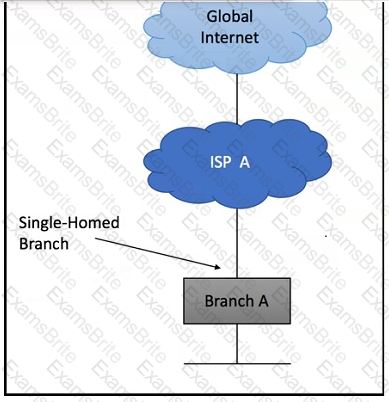
Refer to the exhibit. An architect is designing a BGP solution to connect a remote branch to a service provider. There are several prefixes within the branch that the company does not want to be advertised to the internet. Which solution should the architect use to accomplish this?
Currently, inter-VRF routing between the global routing table and VRF-A is accomplished on the client firewall, but the customer wants to do this on the core network layer. The customer does not want to run BGP, VRF-Lite: or static routing Which mechanism meets the requirements?
What is the role of a control-plane node in a Cisco SD-Access architecture?
An engineer uses Postman and YANG to configure a router with:
OSPF process ID 400
network 192.168.128.128/25 enabled for Area 0
Which get-config reply verifies that the model set was designed correctly?
How do IETF. OpenConfig and Cisco nativo YANG models differ when used to configuro the same feature on an infrastructure device?
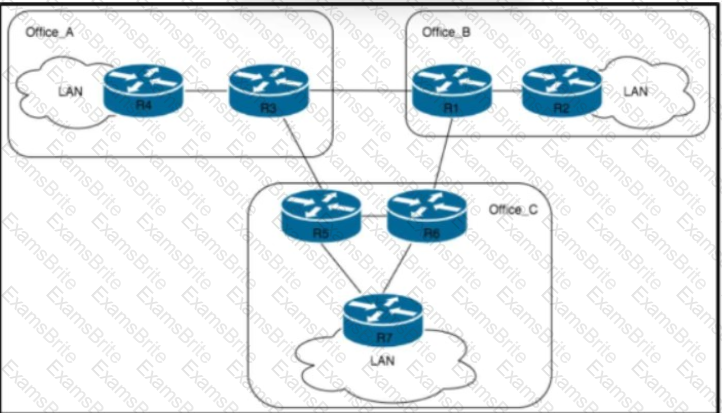
Refer to the exhibit. A company has some offices that are connected via dark fiber in New York. A network architect must optimize the network design based on the EIGRP routing protocol. The network has hierarchical addressing between 10 and 12 routers in each office. Routing convergence time must be at the minimum. What must the network architect do to reduce the query range?
A company wants to switch from static to dynamic routing. The branches use DMVPN back to the hub using two internet connections. One internet connection speed is 10 Mbps, and the other is 100 Mbps. All locations use Cisco routers; however, the branch routers have limited memory and CPU resources. Which routing protocol and design solution must the company choose for optimal traffic forwarding during peak traffic times?
Since installing a cisco TelePresence system, the company is experiencing other application having response issues when the system in use. As a result, the company asked an architect to recommend a QoS solution. The customer is currently using a CBWFQ policy to manage traffic on an internet connection with a speed of 100 Mbps. Which link-capacity limit must the architect choose for strict-priority for the real-time traffic?
An engineer must design a management network for a customer's enterprise network. The design must:
provide the ability to grant and revoke access privileges
allow only protocols SSH, NTP, FTP, and SNMP
restrict access to management Interfaces
Which solution must the engineer choose to meet the requirements?
A company needs to increase access port capacity on one floor of a building. They want to leverage the existing catalyst access switch. There is no problem with uplink bandwidth capacity. However, no additional uplinks can be added because no ports are available on the distribution switches. Which solution must the company choose to provide additional access ports?
A company requested that an architect propose a new IPv4 and IPv6 deployment strategy. The company wants a solution that is straightforward, with no information hiding or forwarding overhead. Which solution meets these requirements?
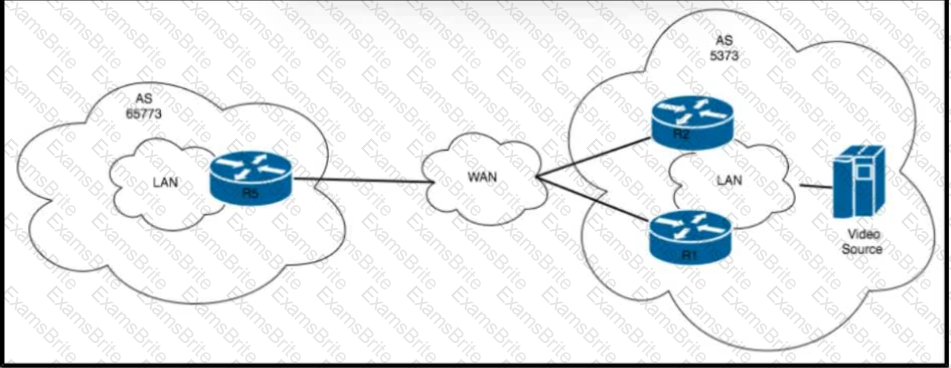
Refer to the exhibit. A company specializing in VoD content creation has two offices in a separate multicast domain connected by a WAN link. BGP communication has been established between the offices. Clients are inside the LAN in each office. In AS5373. R2 has been selected as RP. What must the network architect design to deliver VoD content to clients in AS65773?
How is sub-second failure of a transport link detected in a Cisco SD-WAN network?
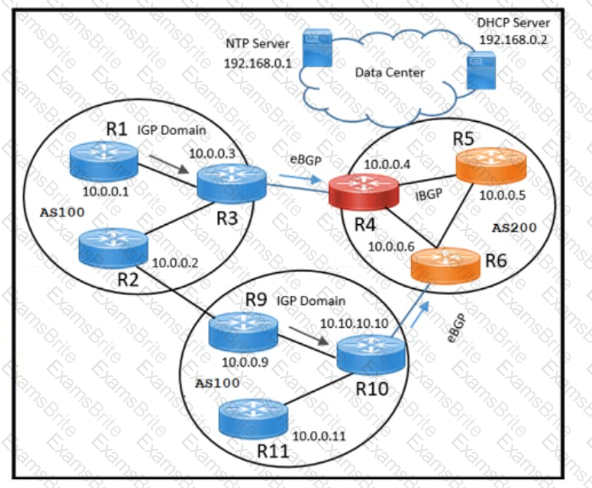
Refer to the exhibit. A network engineer working for a private service provider with an employee ID: 4670:71:451 must design a BGP solution based on:
All traffic originating from AS100 must pass through AS200 to reach the NTP and DHCP server
When a link failure occurs between R3 and R4, traffic must follow the R2-R9 link to reach the NTP and DHCP server.
Which solution must the design include?
An engineer is designing a BGP solution supporting a VXLAN environment over a Layer 3 IPv4 network fabric with these requirements
provide Layer 2 adjacency
allow VM migration of workloads between sites
IGP is OSPF
Which BGP address family must the engineer choose?
Which two techniques improve the application experience in a Cisco SD-WAN design? (Choose two.)
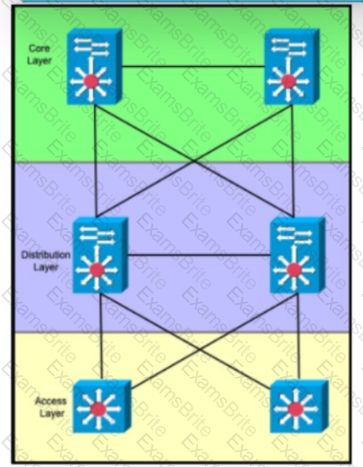
Refer to the exhibit. An engineer Is designing a multicampus Layer 3 Infrastructure using EIGRP as the routing protocol. The design must provide quick replies to queries In the event of a downlink, prevent unnecessary queries, and ensure that traffic does not unnecessarily transit the access layer. Which two actions must the engineer take for the network design? (Choose two.)
What is the purpose of Cisco vBond as a Session Traversal Utilities for NAT server?
In Cisco SD-Access. virtual networks create segmentation that allows for separation of users and resources. How is this type of segmentation described?
An engineer uses Postman and YANG to configure a router with:

Which get-config replay verifies that the model set was designed correctly?





Refer to the exhibit. A Cisco Catalyst switch is configured to.. only one MAC address to be learned manually on interface gkjO/2. Which command must be run to dynamically learn the devices that are connected to the switch port?
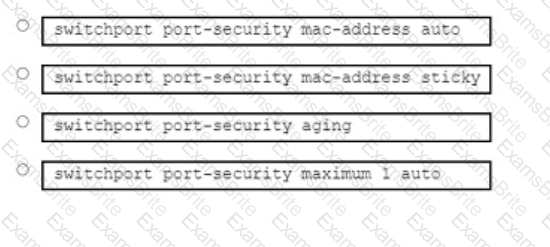
An engineer is designing an EIGRP network for a small branch site where there is only one Layer 3 router. The engineer wants the router to advertise the local LAN network to remote EIGRP neighbors without sending any unnecessary multicast messages on the local LAN. Which action should the engineer take?
When a network is designed using IS-IS protocol, which two circuit types are supported? (Choose two.)
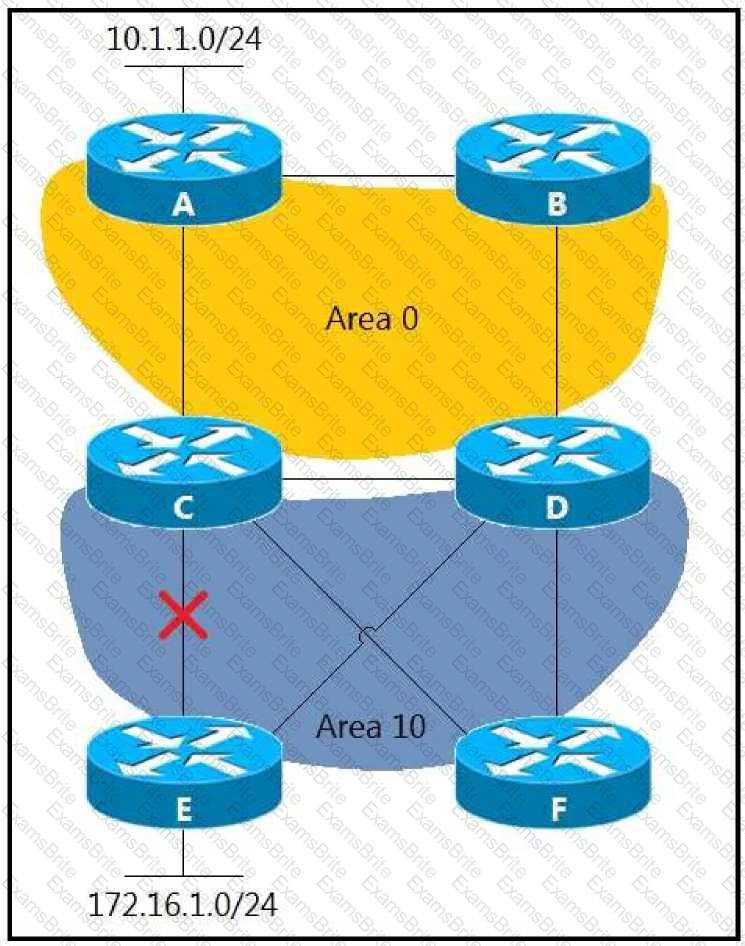
Refer to the exhibit. Area 10 is a regular OSPF area and networks 10.1.1.0/24 and 172.16.1.0/24 are internal. Which design provides optimal routing between both networks when the link between routers C and E fails?
An engineer must design an addressing plan for a small business using a single /24 network. Each department must have its own subnet. Drag and drop the subnets from the left onto the departments requirements that they fulfill on the right. Not all options are used.
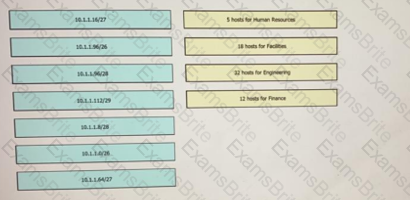
A customer with an IPv4 only network topology wants to enable IPv6 connectivity while preserving the IPv4 topology services. The customer plans to migrate IPv4 services to the IPv6 topology, then decommission the IPv4 topology. Which topology supports these requirements?
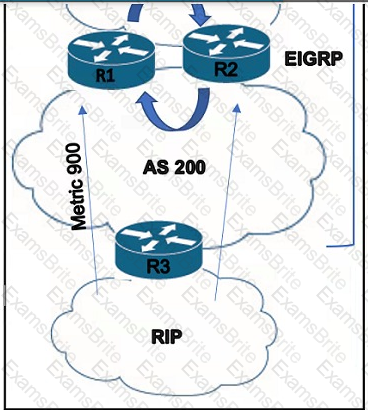
Refer to the exhibit. An architect must design a solution to connect the network behind R3 with the EIGRP network. Which mechanism should be included to avoid routing loops?
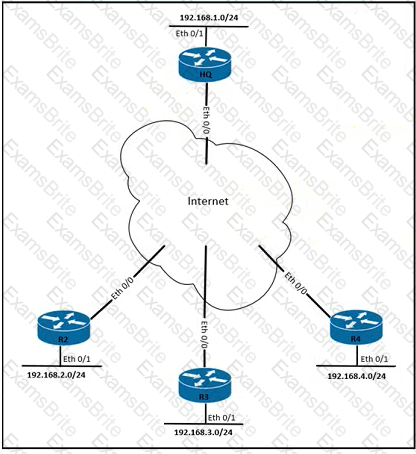
Refer to the exhibit A customer wants to adopt a dynamic site-to-site VPN solution to secure communication for VoIP, video, and FTP traffic between the remote branches and the headquarters. The customer also wants the branches to communicate directly, thereby reducing traffic at the headquarters location. The solution must consider that the branch routers are limited in available memory. Which VPN solution meets these requirements?
Refer to the exhibit.
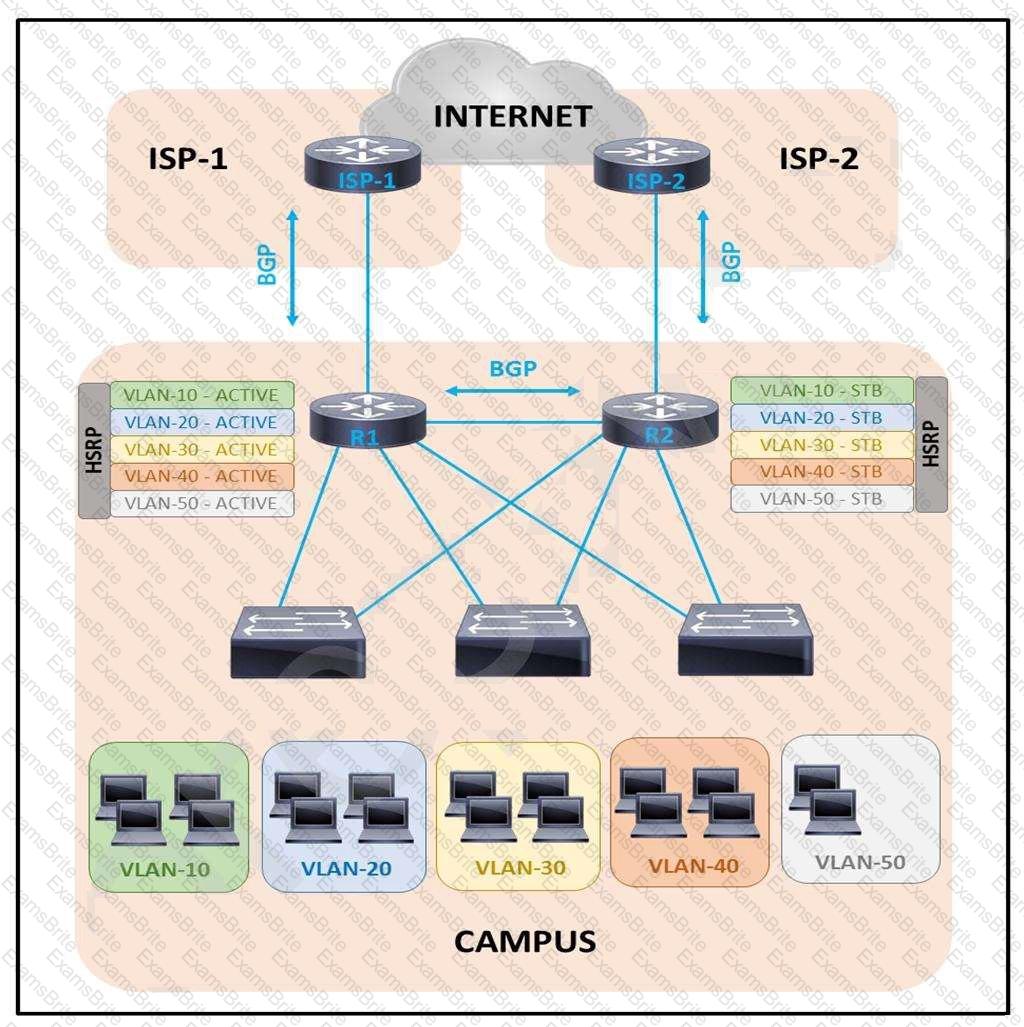
A customer is running HSRP on the core routers. Over time the company has grown and requires more
network capacity. In the current environment, some of the downstream interfaces are almost fully utilized, but
others are not. Which solution improves the situation?
Which solution allows overlay VNs to communicate with each other in an SD-WAN Architecture?
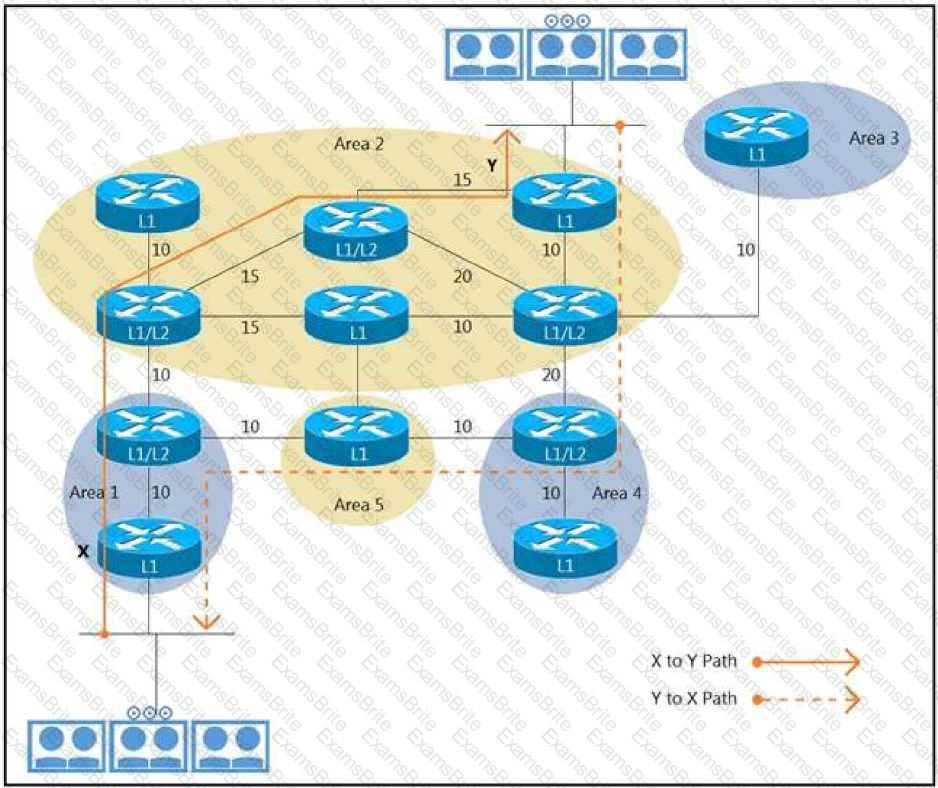
Refer to the exhibit. Customers report low video quality and delays when having point-to-point telepresence video calls between the two locations. An architect must optimize a design so that traffic follows the same path for egress and ingress traffic flows. Which technique optimizes the design?
Which type of rendezvous point deployment is standards-based and supports dynamic RP discovery?
Drag and drop the characteristics from the left onto the YANG models they describe on the right. Not all options are used.
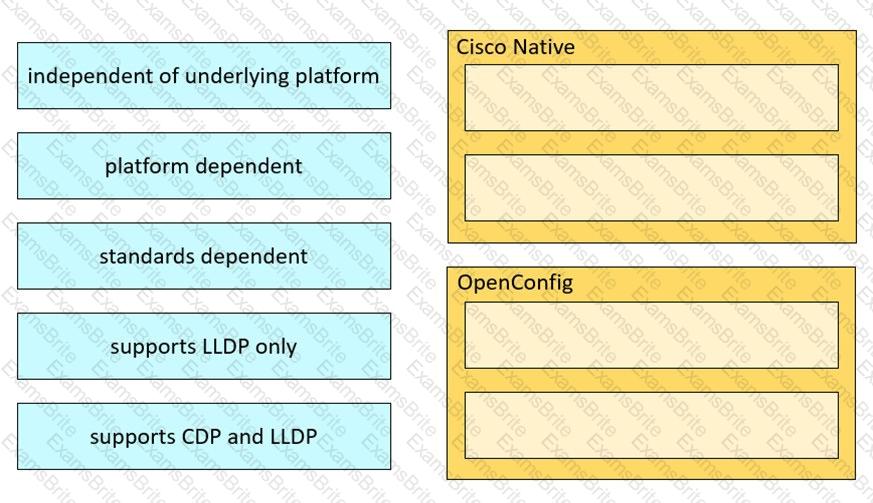
Refer to the exhibit.
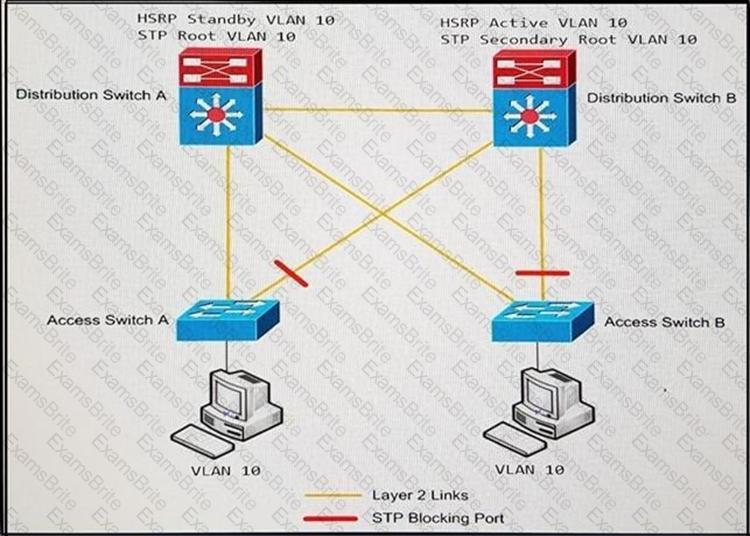
An engineer must optimize the traffic flow of the network. Which change provides a more
efficient design between the access and the distribution layer?
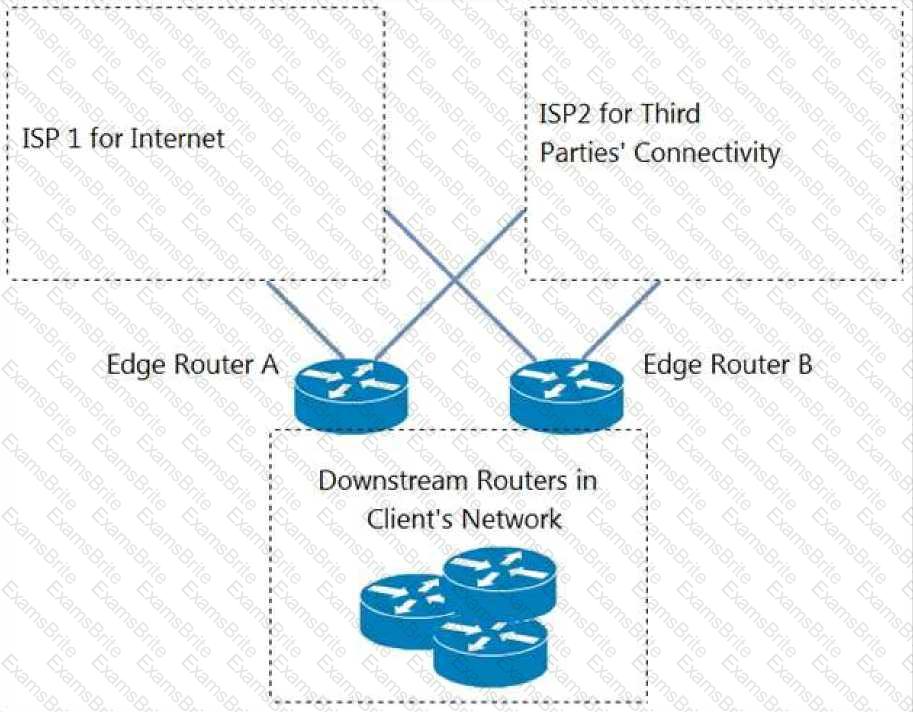
Refer to the exhibit. An engineer is designing a BGP solution for a client that peers with ISP1 for full Internet connectivity and with ISP2 for direct exchange of routes for several third parties. Which action, when implemented on the edge routers, enables the client network to reach the Internet through ISP1?
An engineer is designing a campus network with Cisco Catalyst 95CO switches in the aggression layer. The design requires running nonblocking Layer 2 MEC from the aggregation layer to the access layer. The Catalyst switches are located on different campus floors for availability reasons, and each access switch veil contam a single VLAN. Which technology must the engineer choose for the aggregation switches in the design?
Which feature minimizes TLOC connections and reduces strain on the vSmart controller in an SD-WAN architecture?
An engineer is designing an IPv4 addressing plan for an enterprise with 1000 branches. Each branch requires a prefix for data and a prefix for voice. Each prefix must accommodate up to 128 hosts, and prefixes must facilitate summarization at aggregation points in the network. The security team requires a simple method for identifying voce prefixes. Which allocation does the engineer recommend from the RFC1918 address space?
Drag and drop the types of WAN connectivity from the left onto the connectivity use cases on the right.

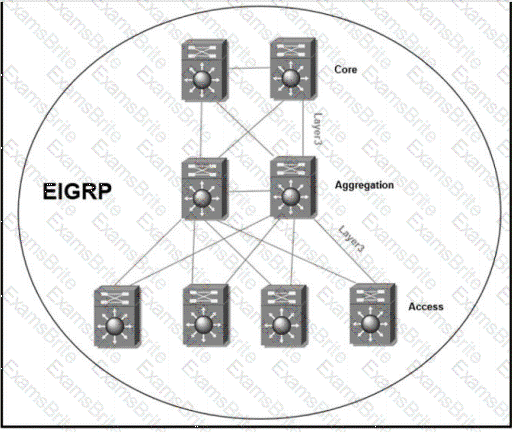
Refer to the exhibit. The full EIGRP routing table is advertised throughout the network. Currently, users experience data loss when any one link in the network fails. An architect optimizes the network to reduce the impact when a link fails. Which solution should the architect include in the design?
How do endpoints inside an SD-Access network reach resources outside the fabric?
An engineer must design a QoS solution for a customer. The network currently supports data only, but the
customer will roll out VoIP and IP video in conjunction with the new QoS solution. The engineer plans to use
DiffServ. To ensure priority for voice services, which model must the design include?
An engineer is designing a PIM Anycast RP solution between two data centers. The design must ensure that RP1 in DC1 and RP2 in DC2 inform each other about specific sources that have joined locally. Which solution must the engineer choose?
A company is using OSPF between its HQ location and a branch office. HQ is assigned area 0 and the branch office is assigned area 1. The company purchases a second branch office, but due to circuit delays to HQ, it
decides to connect the new branch office to the creating branch office as a temporary measure. The new branch office is assigned area 2. Which OSPF configuration enables all three locations to exchange routes?
An engineer is looking for a standards-driven YANG model to manage a multivendor network environment. Which model must the engineer choose?
Which feature provides the capability for intra-VN traffic filtering and control within the Cisco SO-Access architecture?
A network engineer is redesigning a company's QoS solution. The company is currently using IP Precedence, but the engineer plans to move to DiffServ. It is important that the new solution provide backward compatibility with the current solution. Which technology should the design include?
Drag and drop the characteristics from the left onto the correct telemetry mode on the right.
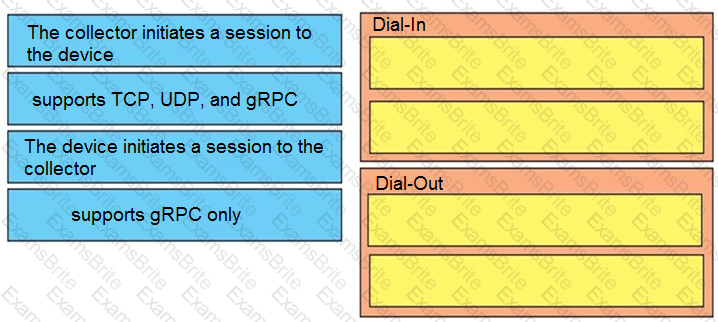
Which information update is carried by OMP and enables the Cisco SD-WAN to build a secure overlay fabric on top of any public or private transport without regard for the actual link IP?
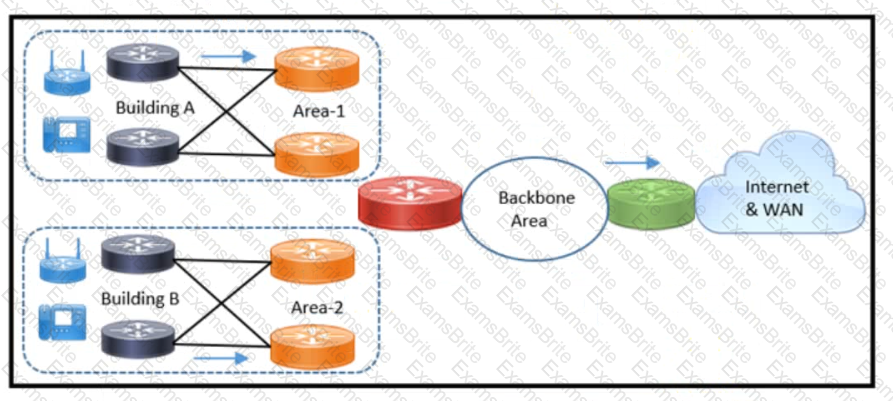
Refer to the exhibit. An architect must design an OSPF solution for an enterprise customer. The design must meet these requirements:
·Limit the link flap impact to Area-1 and Area-2.
·Any link failure must have minimal impact on voice and video traffic.
·Which two OSPF solutions must the architect include in the design? (Choose two.)
Refer to the exhibit.
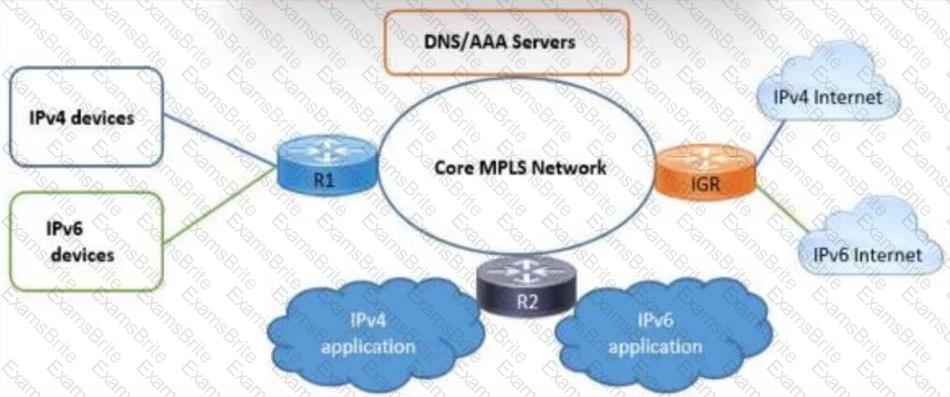
An architect must design an IPv6 migration solution for an enterprise customer to support these requirements:
* Clients will transition to the new IPv6 network, which provides NAT64 and IPv6 DNS resolution services, using the same DNS name that points to the IPv4 address.
* The service provider will create a client-facing IPv6 interface with a new IPv6 virtual address that points to the same IPv4 DNS server.
* The service provider will support clients that use global IPv6 addresses and encapsulate IPv4 packets into IPv6 tunnels.
Which two migration solutions must the architect choose? (Choose two.)
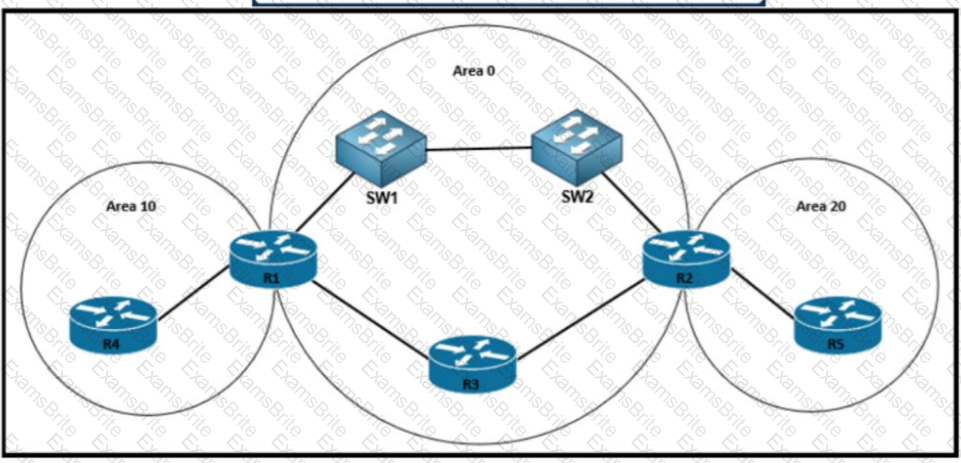
Refer to the exhibit. An architect must ensure a convergence time of 200 ms or less during a link failure within area 0. In addition, the solution must not impact the overall performance of the network. Which solution must the architect select?
In an SD-WAN architecture, which methods are used to bootstrap a vEdge router?
Drag and drop the characteristics from the left onto the telemetry mode they apply to on the right.
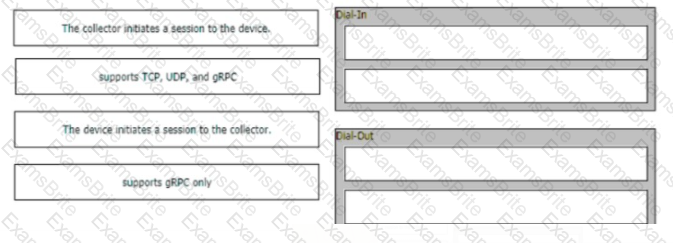
An engineer is creating a design to enable IPv6 to run on an existing IPv4 IS-IS network. The IPv4 and IPv6 topologies will match exactly, and the engineer plans to use the same router levels for each protocol per interface. Which IS-IS design is required?
An engineer must design a solution to connect a customer to the Internet. The solution will include a Layer 3 circuit with a CIR of 50 Mbps from the service provider. The hand-off from the provider's switch to the customer's router is 1Gbps. Which solution should the engineer include to prevent potential issues with choppy voice traffic?
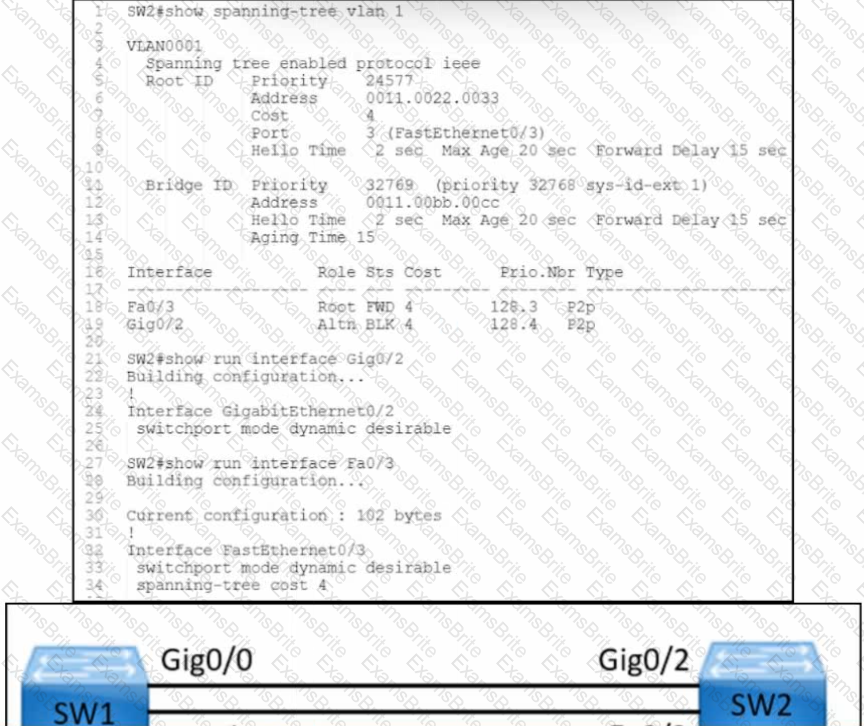

Refer to the exhibits. An engineer is troubleshooting an issue in which the Gig0/2 interface on a Cisco switch named SW2 fails to become the root port. Which two commands must be run on SW2 to resolve this issue? (Choose two.)
A)

B)

C)

D)

E)

An engineer is working with NETCONF and Cisco NX-OS based devices. The engineer needs a YANG model that supports a specific feature relevant only to Cisco NX-OS. Which model must the engineer choose?
An engineer must establish a direct connection between two remote offices. The new connection must be established using a logical path, share a common broadcast domain, connect over private WAN, and have as little overhead as possible. Which technology must the engineer choose?
Which two considerations must be made regarding the overlay network for a Cisco SD-Access architecture? (Choose two.)
An engineer is upgrading a company’s main site to include a connection to a second ISP. The company will receive full Internet routing tables from both ISPs via BGP. The engineer must ensure that the company does not become a transit autonomous system. Which solution should be included in this design?
Refer to the exhibit.
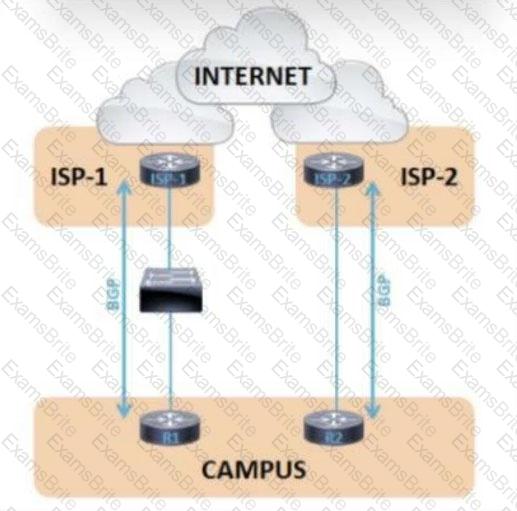
The failover time of ISP-2 is significantly shorter than ISP-1 when an interface on the ISP router toward the campus network fails. Which solution minimizes the downtime to the sub-second?
Company A recently acquired another company. Users of the newly acquired company must be able to access a server that exists on Company A’s network, both companies use overlapping IP address ranges. Which action conserves IP address space and provides access to the server?
Which protocol is deployed through LAN automation to build node-to-node underlay adjacencies in SDA?
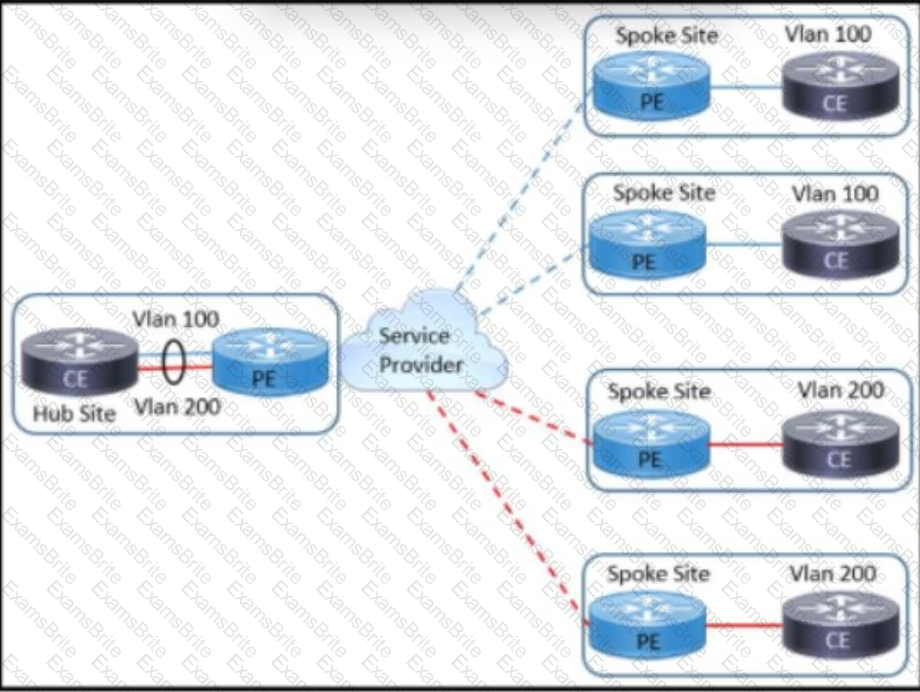
Refer to the exhibit. An architect working for a service provider with an employee ID: 4763:44:876 must design a Layer 2 VPN solution that supports:
transparency of service provider devices
direct communication between CE routers attached to the same VLAN
Which solution must the design include?
Which OSPF area blocks LSA Type 3, 4 and 5, but allows a default summary route?
A network administrator is troubleshooting a DMVPN setup between the hub and the spoke. Which action should the administrator take before troubleshooting the IPsec configuration?
An engineer is designing a QoS solution for a campus. The design must guarantee real-time traffic delivery during congestion, minimize the bandwidth consumption for possible virus or worm attacks, and reduce flooding of excessive traffic during times of congestion. Which two solutions must the engineer select? (Choose two.)
Refer to the exhibit.

An architect is designing a network for a customer supporting a Wake-on-LAN application. Which solution must the architect choose?
In a cisco SD-Access brownfield deployment scenario, which configuration deployment must be taken with Cisco DNA center?
A customer’s environment includes hosts that support IPv6-only. Several of these hosts must communicate with a public web server that has only IPv4 domain name resolution. Which solution should the customer use in this environment?
An architect is creating a migration strategy for a large organization in which the choice made by the application between IPv6 and IPv4 is based on the DNS request. Which migration strategy does the architect choose?
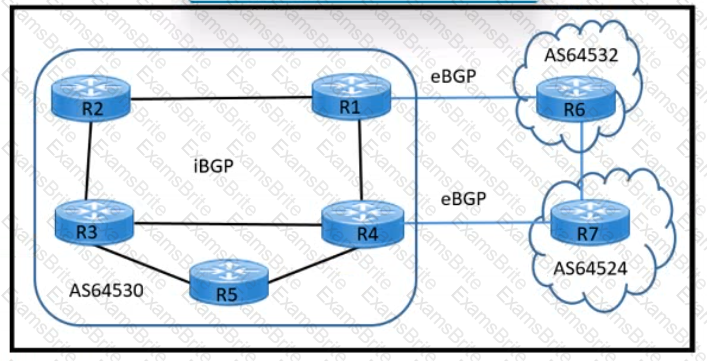
Refer to the exhibit. A network engineer must design a BGP solution based on:
The route reflector must have one or more direct physical connections to the core routers (R3 and R4).
The route reflector must have full redundancy and avoid a single point of failure.
R2 to R1 link utilization is 90%. and the remaining links are less than 50% utilized.
Which two solutions must the design Include? (Choose two.)
A client is moving to Model-Driven Telemetry and requires periodic updates. What must the network architect consider with this design?
An architect is designing a network solution for a customer The network is IPv6-only with 1000 hosts. The design must provide external access to up to 10 concurrent IPv6 hosts to allow communication with legacy IPv4 devices on an adjacent network. The customer set aside 10 IPv4 addresses to allow for one-to-one communication between hosts. Which solution must the architect select?
Which nonproprietary mechanism can be used to automate rendezvous point distribution in a large PIM domain?
Exhibit:
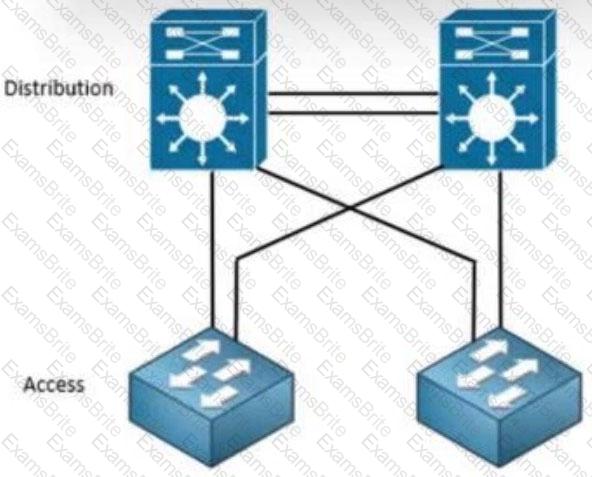
Refer to the exhibit. An engineer is designing a Layer 2 campus network. The design must support fast convergence and leverage as much bandwidth as possible between layers. Distribution switches do support VSS; unfortunately, not all routing protocols are available for use due to license limitations. Which solution must the engineer choose?
Refer to the exhibit.
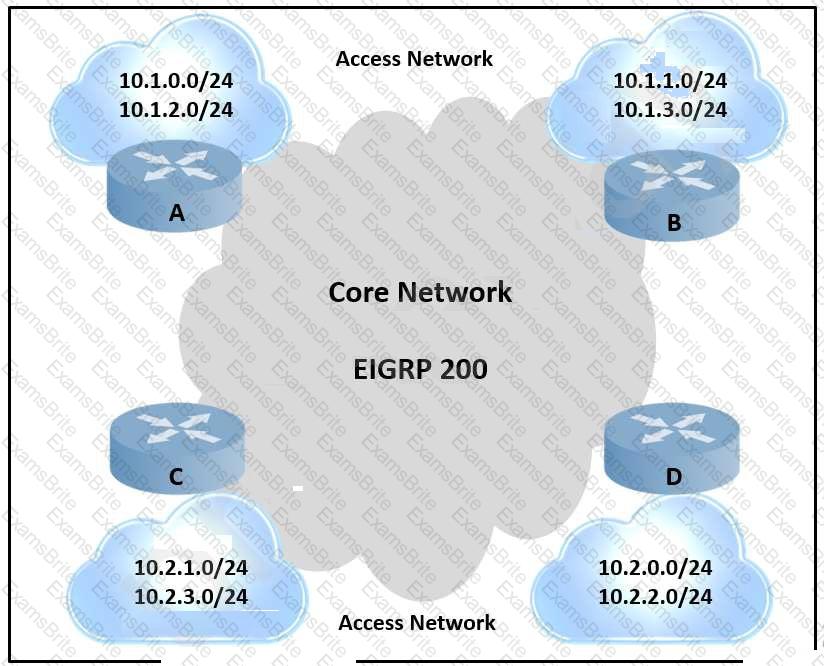
An engineer is designing a routing solution for a customer. The design must ensure that a failure of network
10.1.0.0/24, 10.1.2.0/24, 10.2.1.0/24, or 10.2.3.0/24 does not impact the core. It also requires fast convergence
time during any link failover in the core or access networks. Which solution must the engineer select?
Refer to the exhibit. A network engineer is designing an OSPF solution to connect a company's remote to a newly provisioned MPLS VPN backbone. Some of the branches have a direct dark fiber connection between each other. The engineer wants to ensure that the dark fibers are used only when the MPLS core is unavailable. Which solution must the engineer choose?
Which feature minimizes HOC connections and reduces strain on the vSmart controller m an SO-WAN architecture?
Which two functions does the control plane node provide in a Cisco SD-Access architecture? (Choose two.)